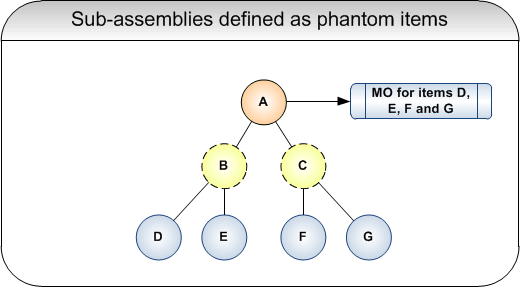Items functioning as sub-assemblies in an item structure can be defined as phantom items. If phantom items exist in an item structure this will affect the creation of manufacturing orders.
Normally, manufacturing orders are created separately for the end item and all its sub-assemblies:

If the sub-assemblies are defined as phantom items only one manufacturing order is created. The material and the operations belonging to the phantom items will be raised to the level of the end item:

The material used by the phantom items is added to the bill of material of the end item and the operations are added to the bill of routing of the end item.
Operation and sequence numbering
The numbering of operations and sequences is affected when phantom items are used. Whether the sequence or operation will keep its original number in the new bill of material/bill of routing depends on several factors.
Three different scenarios exist regarding the numbering of sequences in the new bill of material:
- The original sequence numbers of the sub-assemblies will be used in the bill of material of the end item if the sequence numbers are connected to different items in the bill of routings:
| BOM, end item | BOM, phantom item | New BOM | |||
|---|---|---|---|---|---|
| Sequence | Item | Sequence | Item | Sequence | Item |
| 10 | A | 10 | C | 10 | A |
| 20 | B | ||||
| 20 | D |
- If the sequence number, item and the first operation in the bill of materials of the end item and the phantom item are identical, the quantity reported for the phantom item will be added to that of the end item:
| BOM, end item | BOM, phantom item | New BOM | |||||||||
|---|---|---|---|---|---|---|---|---|---|---|---|
| Seq no | Item | First op | Qty | Seq no | Item | First op | Qty | Seq no | Item | First op | Qty |
| 10 | A | 10 | 4 | 10 | A | 10 | 2 | 10 | A | 10 | 6 |
| 20 | B | 10 | 2 | 20 | C | 10 | 3 | 20 | B | 10 | 2 |
| 20 | C | 10 | 3 |
- If the sequence number and the item coincide but the first operation differs, these will be separated by different sequence numbers:
| BOM, end item | BOM, phantom item | New BOM | |||||||||
|---|---|---|---|---|---|---|---|---|---|---|---|
| Seq no | Item | First op | Qty | Seq no | Item | First op | Qty | Seq no | Item | First op | Qty |
| 10 | A | 10 | 4 | 10 | A | 20 | 2 | 10 | A | 10 | 4 |
| 20 | B | 10 | 2 | 20 | C | 10 | 3 | 11 | A | 20 | 2 |
| 20 | B | 10 | 2 | ||||||||
| 20 | C | 10 | 3 |
The numbering of operations in the new bill of routing depends on the following factors:
- If the operation number and the work centre in the bill of routings are identical, the time reported for the operations for the phantom item will be added to that of the end item:
| BOR, end item | BOR, phantom item | New BOR | ||||||
|---|---|---|---|---|---|---|---|---|
| Op no | WC | Time | Op no | WC | Time | Op no | WC | Time |
| 10 | W01C1 | 2 | 10 | W01C1 | 1 | 10 | W01C1 | 3 |
| 20 | PAINT | 0,5 | 20 | PAINT | 0,5 | 20 | PAINT | 1 |
- If several work centres are connected to the same operation number these will be separated by different operation numbers. In that case the times will not be added to each other:
| BOR, end item | BOR, phantom item | New BOR | ||||||
|---|---|---|---|---|---|---|---|---|
| Op no | WC | Time | Op no | WC | Time | Op no | WC | Time |
| 10 | W01C1 | 2 | 10 | W01C2 | 1 | 10 | W01C1 | 2 |
| 20 | PAINT | 0,5 | 20 | PAINT | 0,5 | 11 | W01C2 | 1 |
| 20 | PAINT | 1 |
Enquiries
- Structure enquiry
- Manufacturing order enquiry